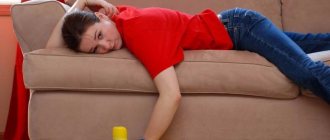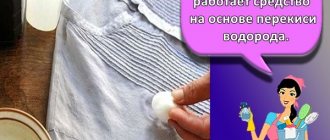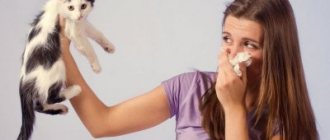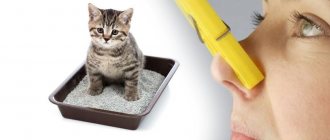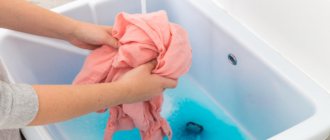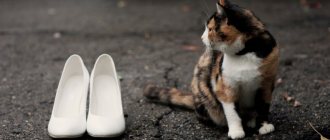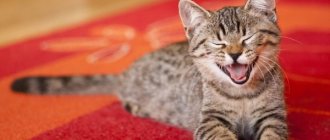04/28/2016 The editors of the site zveridoma.com received a letter from our subscriber Yuri. N. from Volgograd:
Help urgently! I’m selling a car, the other day I took my cat to the dacha. This bastard described the back seat. Fairy soap, an interior cleaner, did not help. I took it to the dry cleaner, but the smell remained! Buyers are shying away, what to do?
We decided to quickly respond to Yuri’s “cry from the heart,” since selling cars is a serious matter! Here are several ways you can use to remove the smell of a naughty cat from the inside of a car, or from furniture at home. For the experiment, we found a suitable car and a couple of described corners of a sofa in a city apartment. In addition, we will describe the experience of our readers who responded to a request for help from the mailing list, for which we are especially grateful. By the way, the smell can remain not only from cats, but also from other animals, but, of course, a cat’s mark is the most difficult to get rid of.
Causes of odor
The smell emitted by cat urine is unusually persistent. Why does my cat's urine stink? The reason is the specific composition of this liquid:
- urochrome – coloring matter;
- urea, which gives a sticky consistency;
- uric acid, which accelerates the process of crystallization of secretions.
An unpleasant odor appears when urea decomposes with the help of bacteria. Decomposition products (thiols) smell even worse. When you try to use traditional detergents to remove "fragrance", only superficial traces are removed. Urine crystals are insoluble in water, so they remain on the surface and after a while the smell appears again.
Traditional methods of eliminating traces of urine
How to remove and neutralize the smell of a kitten at home? Over the centuries of coexistence between people and domestic cats, many ways have been invented to combat the unpleasant consequences of cat marks. Some of the remedies are quite radical and can change the color or texture of the furniture instead of destroying (eliminating) traces of ugliness. Therefore, before using it in an apartment, it is better to test the substance on the least visible area of the surface to be cleaned.
Potassium permanganate solution (potassium permanganate)
A solution of potassium permanganate reacts with ammonia molecules. The stench disappears, but the surface turns pink. The water-repellent coating must be immediately washed with clean water to remove excess potassium permanganate. If the surface absorbs moisture, the color will remain forever. When preparing a solution for removal, you must thoroughly stir the liquid to dissolve the raspberry crystals.
Vinegar
Prepare a solution of vinegar and water in a ratio of 1:2 and spray from a spray bottle onto problem areas. After such treatment, the surface should be washed, and the clothes should be washed and sent to the wash.
Lemon juice
Mix the juice of half the fruit with 100 ml of water and pour into a fragrant corner. It is not recommended to wash off, since the strong aroma of citrus fruits will not allow the cat to leave marks in the same place again.
Soda with hydrogen peroxide
This method has worked well for removing urine stains from carpets and upholstered furniture. Sprinkle a thick layer of baking soda powder onto the stain and pour in peroxide. Leave the mixture for 12 hours, then remove the remaining mixture with a cloth soaked in soapy water.
You can do it differently: mix 15 g of peroxide, 2 tbsp. l. soda powder and pour into a bottle with soap solution. Pour the mixture onto the stain, then rinse.
Iodine
Dilute 10 drops of iodine in 2 glasses of water. Wet the stain with the mixture, wait 3 hours, then rinse. This method is not suitable for light-colored coatings, since iodine has a coloring property.
Glycerin soap
To remove dirt from furniture upholstery, carefully treat the stained area with a moistened bar of soap. Then you should go over the dirt with a stiff brush, rinse and dry.
Laundry soap
Grate a bar of soap, add heated water, and stir. When the composition becomes homogeneous, rub the mixture into the marked area, wait half an hour and rinse with warm water.
Vodka
Trying to remove a urine stain or smell with vodka is useless. You can only discourage the cat from using this place as a toilet again, since alcohol stinks and cats can smell it a mile away. Other residents will also have to put up with the annoying aroma.
Soda plus salt
This method is recommended for cleaning rugs or sleeping areas. The stained area of the cat's mark is filled with soda and sprinkled with a layer of salt. Leave for 3-4 hours, then rinse thoroughly with warm water.
All of the above methods are suitable for eliminating fresh contamination. To eliminate old traces of cat litter, you will have to use a combination of these products or take the item to the dry cleaner.
Sunday, January 05, 2014
How to get rid of the smell of cat urine in the car interior?!
Initially I was glad that the seat was leather, urine leaked through the gap and flowed onto the rear carpet. But it's not that simple. After 30 minutes, I washed everything he had soiled with a strong bleach solution. To my surprise, this did not help at all. For the next week, I burned incense sticks in the car while I was driving. It overwhelmed the smell. But I myself was imperceptibly saturated with the smell of cat urine. Things and even skin stank. I was ashamed to go about my business. It seemed like I smelled like a homeless person. He didn’t let his wife into the front seat. And then it seemed like it didn’t stink anymore. I sniffed it and got used to it. But a two-hour drive around the city said otherwise. The smell permeated the fur coat and through it the skirt. Tough!
PS I wanted to take a photo of the process, but I forgot my camera. I had to take pictures with my phone. But he doesn’t pick up objects well in the dark.
PS Another option, lemon juice. I haven't tried it. But if I have to and use it, I’ll write about it.
Update dated January 27, 2014.
Iodine turned out to be a super effective remedy. After drying, the seat, as well as the floor in the car, give off the smell of iodine, but this is much more pleasant than the stench of cat urine. There was no trace of urine left. The smell of iodine, if it does not disappear on its own, can be removed by ordinary treatment with a washing vacuum cleaner at a car wash.
Professional odor neutralizers
If it is not possible to remove the cat’s waste using a homemade method, you will have to use professional odor eliminators. The modern chemical industry produces a large list of products designed to completely eliminate unpleasant odors.
Shredder “8 in 1 NM advanced”
An effective product for removing old stains, including vomit, grass, urine and blood stains. Active oxygen and bio-enzymes included in the product guarantee complete cleaning and remove odors. The destroyer is recommended for use on carpets, cat litter boxes, soft and hard surfaces, and fabrics.
Dezosan
The composition, working at the molecular level, is designed to completely eliminate unpleasant odors. Recommended for use in washing vacuum cleaners.
Odor kill
After using this vanilla-smelling product, the aromas of burning, smoke, fur and pet feces will completely disappear from the air. Method of application: the drug is dissolved in water and sequential treatment of all coatings in the room, both hard and fleecy, is carried out. Per 100 sq. m. surface will need 1 liter of product.
Odor Gone
The herbal drug is produced at Russian enterprises under an American patent. Advantages:
- natural composition;
- disinfecting properties;
- no allergic effect;
- economical (up to 10 sprays of spray per room).
Thornell Cat Odor -off
After spraying the remover, the smell of urine and feces is completely eliminated, quickly replaced by a fresh aroma. The product can be applied to any coating.
Urine -off
Designed to completely neutralize uric acid crystals that cause unpleasant odors. The reaction products are completely harmless: water and carbon dioxide. The drug stabilizer also serves to block cat pheromones. This quality makes it possible to exclude that the cat will want to mark the treated area again. Urine-off does not contain allergens or toxic chemicals and is recommended for areas where small children live and in cars.
Chemical method of urine decomposition
How to remove and decompose cat urine at a chemical level? To eliminate foul-smelling traces of a cat's activity, you can use a recipe designed to remove the stench of skunk excretions. The urine of these animals contains protein compounds that serve as a source of discomfort for others. The process involves two stages: removal of uric acid, and then neutralization of thiols. Required ingredients: nine percent vinegar, soda, hydrogen peroxide and dishwashing liquid.
Procedure:
- 1) Remove moisture using paper napkins or cat litter.
- 2) Dilute vinegar with water in a ratio of 1:3. Pour the solution over the treated area and leave to dry. At this stage, urine is destroyed.
- 3) After the vinegar has completely evaporated, lightly sprinkle the stain with baking soda powder and immediately proceed to the next step.
- 4) Combine hydrogen peroxide with an equal amount of water, add a teaspoon of liquid dish soap. Spray the mixture over a surface sprinkled with baking soda until foam appears. Wait for the reaction results (2-3 hours). The chemical reaction serves to produce oxygen, which neutralizes the thiols. Liquid soap is used to create foam that traps oxygen in the dirty area.
- 5) Remove dry mixture residues using a vacuum cleaner.
Using this method to eliminate odor is not only effective, but also does not require large expenses, since all components are inexpensive. The method can be widely used for cleaning entrances, elevators and other public areas. To remove old, stubborn dirt, pre-treatment with enzymes is recommended. A day after cleaning, you should treat the stain with vinegar, and another day later - with a mixture of soda and peroxide.
The vinegar in the recipe can be replaced with ethyl or isopropyl alcohol, but these substances are very toxic and can cause serious poisoning.
Cleaning various surfaces
In order not to spoil the material during cleaning, before using the cleaning composition, you need to check the reaction on a small area of the coating.
Sofas, armchairs
For fabric coverings, the best solution would be potassium permanganate (for dark colors), vinegar solution or lemon juice.
Laminate, linoleum, parquet
Wipe the surface with a solution of vinegar or lemon juice, leaving the floor damp. After an hour, you can remove any remaining moisture by wiping the floor dry.
Bed
It is recommended to remove stains from mattresses, blankets and bed linen using sparkling water and salt. After pouring water and adding a layer of salt, wait 2-3 hours, then wash off the residue.
Shoes, sneakers
Is it possible to wash cat piss off shoes? Tags on shoes are the most difficult to remove. If the marks are fresh, you should try to get rid of moisture by placing napkins or newspaper inside the shoes, and then wash the shoes with laundry soap.
If the mark has already become old, it is recommended to repeat the washing procedure several times, and then wipe the shoes with a vinegar solution. Fabric shoes can be washed in a washing machine. If your boots continue to smell unpleasant, it is better to buy an odor neutralizer from a pet pharmacy.
Carpet
The general rule that a fresh tag is easier to remove also applies in this case. You can use a solution of vinegar, lemon juice or laundry soap. It is recommended to pour vinegar over old stains and cover them with baking soda powder.
Cloth
It is better to simply wash and rinse soiled clothes, jackets, and stains in a weak vinegar solution.
Wooden furniture
Cover the stain with an even layer of baking soda. Wait 40 minutes, then remove the residue and spread the surface with laundry soap. To enhance the effect, the soap must first be grated and soaked.
House plants
Plants are treated by watering. Add an activated carbon tablet to 1 liter of water.
Precautionary measures
Frequent use of cleaning liquids containing chlorine can negatively affect the well-being of people and animals.
Vinegar and lemon solutions greatly dry out the surfaces being treated. After such treatment, the leather may crack and dry out, so it is recommended to use special products for the care of shoes or leather upholstery.
Coatings with a large number of pores (wood, concrete) require repeated treatment and pre-soaking with vinegar solution. During major repairs, it is recommended to burn the concrete floors using a blowtorch.
Fabrics that have been cleaned with peroxide should be washed with the addition of 100-150 ml of apple cider vinegar.
Privacy Policy
Introduction
We are committed to respecting the personal information of visitors to our site. This Privacy Policy explains some of the measures we take to protect your privacy.
Confidentiality of personal information
“Personally identifiable information” means any information that can be used to identify an individual, such as name or email address. Use of private information. Personally identifiable information collected through our site is used by us, among other things, for the purposes of registering users, maintaining and improving our site, tracking policies and site usage statistics, and for purposes authorized by you.
Disclosure of private information...
We employ other companies or are affiliated with companies that provide services on our behalf, such as processing and delivering information, posting information on this site, delivering content and services provided by this site, and performing statistical analysis. To enable these companies to provide these services, we may share personal information with them, but they will only be permitted to receive the personal information they need to provide the services. They are required to keep this information confidential and are prohibited from using it for other purposes. We may use or disclose your personal information for other reasons, including if we believe it is necessary to comply with the law or court orders, to protect our rights or property, or to protect the personal safety of users of our site or members of the general public. , to investigate or take action regarding illegal or suspected illegal activity, in connection with a corporate transaction such as a divestiture, merger, consolidation, sale of assets or in the unlikely event of bankruptcy, or for other purposes consistent with your consent. We will not sell, rent or lease our user lists with email addresses to third parties.
Access to personal information.
If, after providing information to this site, you decide that you do not want your personal information to be used for any purpose, please contact us at the following address: [email protected]
Our Practices Regarding Non-Personal Information.
We may collect non-personal information about your visit to the site, including the pages you view, the links you click, and other activities in connection with your use of our site. In addition, we may collect certain standard information that your browser sends to any website you visit, such as your IP address, browser type and language, time spent on the site, and the address of the website in question.
Using bookmarks (cookies).
Aggregated information.
We may combine in a non-identifiable format the personal information you provide and the personal information provided by other users, thereby creating aggregate data. We plan to analyze aggregated data primarily for the purpose of tracking group trends. We do not link aggregated user data to personally identifiable information, so aggregated data cannot be used to contact or identify you. Instead of using actual names, we will use usernames during aggregate data creation and analysis. For statistical purposes and to track group trends, anonymous, aggregated data may be provided to other companies with whom we interact.
Changes to this Privacy Statement.
Source
Common Misconceptions
One of the common mistakes that owners of furry pets make is punishment without clarifying the circumstances. A cat may mark territory for the following reasons:
- stressful state;
- urinary system disease;
- tail injury;
- uncomfortable tray;
- poor selection of toilet filler.
The second most common mistake is the decision to postpone cleaning until a more favorable time. A fresh stain is much easier to remove, but old urine residue will attract the cat to repeat the violation again.
The third misconception is related to the second and is to get rid of the smell at any cost. The use of deodorants and fragrances (coffee, aromatic oils, incense) relieves the human nose from suffering, but the cat will still feel its marks and will get used to using the marked area of the home space for the toilet.
Chlorine-based products disinfect well, but the stench only intensifies after such cleaning.
Proven synthetic special detergents
Oddly enough, the famous “anti-odor” products and fresheners to eliminate the effects of transporting impatient animals in the car did not help. Despite prolonged ventilation. However, they worked great when combined with cleaners (for example, Profoam car interior and upholstery cleaner). First a cleaner, then an anti-pet odor agent. According to reviews, “Urinn Off” has proven itself very well (there are separate formulas for the smell of cats and dogs).
Foam for cleaning car seats really helps, which is applied to the surface, absorbed for a while, and then comes out and wiped with a cloth or brush, taking away stains and odor with it. There are quite a few brands, we won’t mention many so as not to be perceived as advertising. Two of the products we tested (on home furniture) are very effective: Gank (USA), Sonax (Germany).
Lenore fabric softener does a good job of removing cat odor, but is not very effective against stains on car seat upholstery.
Tips for renovation
The presence of pets in the home imposes additional obligations on owners. Compliance with a number of requirements when renovating a home will help the animal owner to significantly simplify the life of himself and his charges.
When arranging the floor, fleecy coverings should be avoided. It is impossible to properly clean such surfaces, so the carpet floor will always serve as a source of dirt and infection.
Laminate looks no worse than parquet, but urine easily gets into the holes between the boards, promoting rot. Wooden or varnished parquet floors are much more hygienic.
When laying baseboards, you should carefully seal the joints, leaving no holes between the floor and walls. It is recommended to lay an insulating film on top of concrete floors to prevent the concrete from getting wet.
When choosing linoleum, you should give preference to a material with a waterproof synthetic lining.
Tile or ceramic tiles should only be attached with an adhesive base. Using the solution creates cavities into which urine can leak through the seams between the tiles. For high-quality sealing of seams, you need to use a polymer-based grout to protect against corrosion by uric acid.
The best choice for a home with cats and dogs would be epoxy self-leveling floors.
Cleaning the house will be greatly facilitated if the lower part of the walls is painted with paints that can be washed using brushes and chemicals. It is not recommended to use paper and fabric wallpaper. The plaster should also be checked for acid resistance before installation.
For cleaning, it is recommended to use a water vacuum cleaner.
Preventive measures
The urine of warm-blooded animals contains protein processing products. After leaving the body, these substances become a breeding ground for bacteria. This process causes an unpleasant odor and a source of infection.
To stop the appearance of puddles of urine in secluded places at home, the pet owner should pay attention to the possible causes of unwanted behavior:
- The cat is unhappy with the tray. Perhaps the animal does not like the configuration of the tray or the owner does not bother himself too much with the timely replacement of the filler.
- An annoying person or piece of furniture has appeared in the house. When marking territory, the cat exhibits a defensive reaction.
- Old age or illness. If your pet did not suffer from such abnormalities as a child, you should take the cat to a veterinarian for a diagnosis.
- Tail injury often interferes with the natural fulfillment of needs.
- Sexual activity. An animal that is not subject to mating must be sterilized or neutered.
- The tray is located in an inconvenient place. Cats generally prefer quiet corners away from light.
- Not enough trays. If there are several pets, the number of toilets should be increased.
- Increased love for cleanliness. Some cats separate litter boxes for large and small needs. Installing a second tray will help solve the problem.
To prevent problems from reoccurring after removal of contamination, it is recommended:
- Treat surfaces using proprietary preparations from a veterinary pharmacy.
- Scatter the peels of oranges or tangerines. The smell of essential oils will repel your pet.
- Place vials with ground pepper or coffee in the marked places, having previously drilled the lids.
- If the cause of the problem is heat, the pet should be sterilized.
Prevention measures
To prevent such troubles from happening again, there are some recommendations. It is important to monitor the behavior and health of your pet, and follow the rules of keeping. A cat may shit if it is not happy with the litter box. This item must meet some requirements:
- always be in a clean state;
- have high sides;
- have a sufficient amount of filler inside;
- have dimensions corresponding to the size of the cat itself;
- located in a suitable place that is comfortable for the animal.
In order for the kitten to quickly get used to the right place, when an urge or suspicious behavior appears, the person must move it. This process can take from several days to a week. Sometimes there are cases when the animal needs a longer time.
Antigadin spray
This remedy is well known to all cat owners. With its help, a person points out where the pet should not shit and put marks. This effect is achieved by a special composition to which the animal reacts sensitively. A person does not smell it at all.
It is necessary to treat with it those places where the cat often tries to go to the toilet. You can buy it in veterinary stores or supermarkets, in the pet products department.
